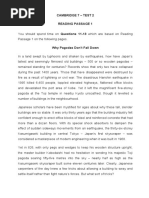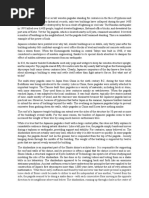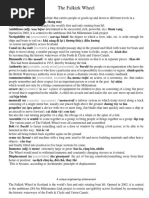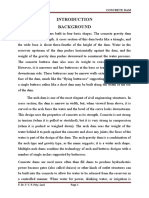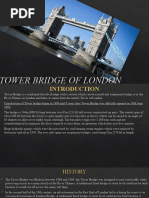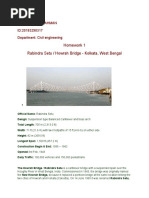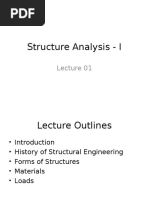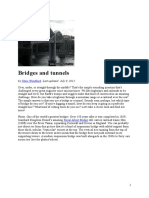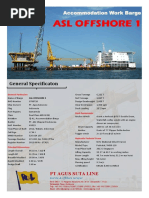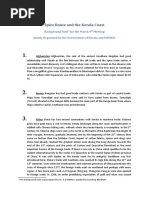0 ratings0% found this document useful (0 votes)
9 viewsMindset 1 - UNIT 2
Mindset 1 - UNIT 2
Uploaded by
tuyethoa.nguyen299Copyright:
© All Rights Reserved
Available Formats
Download as DOCX, PDF, TXT or read online from Scribd
Mindset 1 - UNIT 2
Mindset 1 - UNIT 2
Uploaded by
tuyethoa.nguyen2990 ratings0% found this document useful (0 votes)
9 views6 pagesCopyright
© © All Rights Reserved
Available Formats
DOCX, PDF, TXT or read online from Scribd
Share this document
Did you find this document useful?
Is this content inappropriate?
Copyright:
© All Rights Reserved
Available Formats
Download as DOCX, PDF, TXT or read online from Scribd
Download as docx, pdf, or txt
0 ratings0% found this document useful (0 votes)
9 views6 pagesMindset 1 - UNIT 2
Mindset 1 - UNIT 2
Uploaded by
tuyethoa.nguyen299Copyright:
© All Rights Reserved
Available Formats
Download as DOCX, PDF, TXT or read online from Scribd
Download as docx, pdf, or txt
You are on page 1of 6
UNIT 2: PLACES AND BUILDINGS
PASSAGE 1
Why pagodas don't fall down
In a land swept by typhoons
and shaken by earthquakes,
how have Japan's tallest and
seemingly flimsiest old
buildings - 500 or so
wooden pagodas - remained
standing for centuries?
Records show that only two
have collapsed during the
past 1400 years. Those that
have disappeared were
destroyed by fire as a result
of lightning or civil war. The
disastrous Hanshin
earthquake in 1995 killed
6,400 people, toppled
elevated highways,
flattened office blocks and
devastated the port area of
Kobe. Yet it left the magnificent five-storey pagoda at the Toji temple in
nearby Kyoto unscathed, though it leveled a number of buildings in the
neighborhood.
Japanese scholars have been mystified for ages about why these tall, slender
buildings are so stable. It was only thirty years ago that the building
industry felt confident enough to erect office blocks of steel and reinforced
concrete that had more than a dozen floors. With its special shock absorbers
to dampen the effect of sudden sideways movements from an earthquake,
the thirty-six-storey Kasumigaseki building in central Tokyo - Japan's first
skyscraper - was considered a masterpiece of modern engineering when it
was built in 1968.
Yet in 826, with only pegs and wedges to keep his wooden structure upright,
the master builder Kobodaishi had no hesitation in sending his majestic Toji
pagoda soaring fifty-five metres into the sky - nearly half as high as the
Kasumigaseki skyscraper built some eleven centuries later. Clearly,
Japanese carpenters of the day knew a few tricks about allowing a building
to sway and settle itself rather than fight nature's forces. But what sort of
tricks?
The multi-storey pagoda came to Japan from China in the sixth century. As
in China, they were first introduced with Buddhism and were attached to
important temples. The Chinese built their pagodas in brick or stone, with
inner staircases, and used them in later centuries mainly as watchtowers.
When the pagoda reached Japan, however, its architecture was freely
adapted to local conditions - they were built less high, typically five rather
than nine storeys, made mainly of wood and the staircase was dispensed
with because the Japanese pagoda did not have any practical use but became
more of an art object. Because of the typhoons that batter Japan in the
summer, Japanese builders learned to extend the eaves of buildings further
beyond the walls. This prevents rainwater gushing down the walls. Pagodas
in China and Korea have nothing like the overhang that is found on pagodas
in Japan.
The roof of a Japanese temple building can be made to overhang the sides of
the structure by fifty per cent or more of the building's overall width. For
the same reason, the builders of Japanese pagodas seem to have further
increased their weight by choosing to cover these extended eaves not with
the porcelain tiles of many Chinese pagodas but with much heavier
earthenware tiles.
Question 1 - 4
Do the following statements agree with the claims of the writer in Reading
Passage?
In boxes 1-4 on your answer sheet, write
YES if the statement agrees with the claims of the writer
NO if the statement contradicts the claims of the writer
NOT GIVEN if it is impossible to say what the writer thinks about this
1 Only two Japanese pagodas have collapsed in 1400 years.
2 The Hanshin earthquake of 1995 destroyed the pagoda at the Toji temple.
3 The other buildings near the Toji pagoda had been built in the last 30
years.
4 The builders of pagodas knew how to absorb some of the power produced
by severe weather conditions.
Question 5-9
Classify the following as typical of
A both Chinese and Japanese pagodas
B only Chinese pagodas
C only Japanese pagodas
Write the correct letter, A, B or C, in boxes 5-10 on your answer sheet.
5 easy interior access to top
6 tiles on eaves
7 use as observation post
8 size of eaves up to half the width of the building
9 original religious purpose
PASSAGE 2
The Falkirk Wheel
A unique engineering achievement
The Falkirk Wheel in Scotland is the world's first and only rotating boat lift.
Opened in 2002, it is central to the ambitious £84.5m Millennium Link
project to restore navigability across Scotland by reconnecting the historic
waterways of the Forth & Clyde and Union Canals.
The major challenge of the project lies in the fact that the Forth & Clyde
Canal is situated 35 meters below the level of the Union Canal. Historically,
the two canals had been joined near the town of Falkirk by a sequence of 11
locks - enclosed sections of canal in which the water level could be raised or
lowered - that stepped down across a distance of 1.5 km. This had been
dismantled in 1933, thereby breaking the link.
The various parts of The Falkirk Wheel were all constructed and assembled,
like one giant toy building set, at Butterley Engineering's Steelworks in
Derbyshire, some 400 km from Falkirk.
A team there carefully assembled the 1,200 tonnes of steel, painstakingly
fitting the pieces together to an accuracy of just 10 mm to ensure a perfect
final fit. In the summer of 2001, the structure was then dismantled and
transported on 35 lorries to Falkirk, before all being bolted back together
again on the ground, and finally lifted into position in five large sections by
crane. The Wheel would need to withstand immense and constantly
changing stresses as it rotated, so to make the structure more robust, the
steel sections were bolted rather than welded together. Over 45,000 bolt
holes were matched with their bolts, and each bolt was hand-tightened.
The Wheel consists of two sets of opposing axe-shaped arms, attached
about 25 metres apart to a fixed central spine.
Two diametrically opposed water-filled 'gondolas', each with a capacity of
360,000 litres, are fitted between the ends of the arms. These gondolas
always weigh the same, whether or not they are carrying boats.
This is because, according to Archimedes' principle of displacement,
floating objects displace their own weight in water. So when a boat enters a
gondola, the amount of water leaving the gondola weighs exactly the same
as the boat. This keeps the Wheel balanced and so, despite its enormous
mass, it rotates through 180° in five and a half minutes while using very
little power. It takes just 1.5 kilowatt-hours (5.4 MJ) of energy to rotate the
Wheel -roughly the same as boiling eight small domestic kettles of water.
Boats needing to be lifted up enter the canal basin at the level of the Forth &
Clyde Canal and then enter the lower gondola of the Wheel. Two hydraulic
steel gates are raised, so as to seal the gondola off from the water in the
canal basin. The water between the gates is then pumped out. A hydraulic
clamp, which prevents the arms of the Wheel moving while the gondola is
docked, is removed, allowing the Wheel to turn. In the central machine
room an array of ten hydraulic motors then begins to rotate the central axle.
The axle connects to the outer arms of the Wheel, which begin to rotate at a
speed of 1/8 of a revolution per minute. As the wheel rotates, the gondolas
are kept in the upright position by a simple gearing system. Two eight-
meter-wide cogs orbit a fixed inner cog of the same width, connected by
two smaller cogs traveling in the opposite direction to the outer cogs - so
ensuring that the gondolas always remain level. When the gondola reaches
the top, the boat passes straight onto the aqueduct situated 24 meters above
the canal basin.
The remaining 11 meters of lift needed to reach the Union Canal is achieved
by means of a pair of locks. The Wheel could not be constructed to elevate
boats over the full 35-meter difference between the two canals, owing to the
presence of the historically important Antonine Wall, which was built by the
Romans in the second century AD.
Boats travel under this wall via a tunnel, then through the locks, and finally
on to the Union Canal.
Questions 1-6
Do the following statements agree with the information given in Reading
Passage?
in boxes 1-6 on your answer sheet, write
TRUE if the statement agrees with the information
FALSE if the statement contradicts the information
NOT GIVEN if there is no information on this
1 The Falkirk Wheel has linked the Forth & Clyde Canal with the Union Canal
for the first time in their history.
2 There was some opposition to the design of the Falkirk Wheel at first.
3 The Falkirk Wheel was initially put together at the location where its
components were manufactured.
4 The Falkirk Wheel is the only boat lift in the world which has steel sections
bolted together by hand.
5 The weight of the gondolas varies according to the size of boat being
carried.
6 The construction of the Falkirk Wheel site took into account the presence
of a nearby ancient monument.
Questions 7-13
Label the diagram below.
Choose ONE WORD from the passage for each answer.
Write your answers in boxes 7-13 on your answer sheet.
You might also like
- Akashi Kaikyo BridgeDocument6 pagesAkashi Kaikyo BridgePriyanjita Adhikari100% (2)
- DNVGL-ST-0498 (2018) Launching Appliances For Work Boats and Tender BoatsDocument89 pagesDNVGL-ST-0498 (2018) Launching Appliances For Work Boats and Tender BoatsJulio Andrés Casal Ramos100% (1)
- Punonghimpilan Tanod Baybayin NG Pilipinas: (Headquarters Philippine Coast Guard)Document6 pagesPunonghimpilan Tanod Baybayin NG Pilipinas: (Headquarters Philippine Coast Guard)Altitude Maritime TrainingCenterNo ratings yet
- Article - 2Document2 pagesArticle - 2AzzamNo ratings yet
- Why Pagodas Don't Fall DownDocument4 pagesWhy Pagodas Don't Fall Downhieuccc20No ratings yet
- IELTS Academic Reading Sample 33 - Why Pagodas Dont Fall DownDocument5 pagesIELTS Academic Reading Sample 33 - Why Pagodas Dont Fall Downmuhammad bilal ahmadNo ratings yet
- (Reading Practice) CAMBRIDGE 7 - TEST 2 - PASSAGE 12Document5 pages(Reading Practice) CAMBRIDGE 7 - TEST 2 - PASSAGE 12Hảo HoàngNo ratings yet
- IN - Why Pagodas Don't Fall DownDocument4 pagesIN - Why Pagodas Don't Fall Downminhthu2803stNo ratings yet
- Classification TaskDocument4 pagesClassification Taskapi-347421222No ratings yet
- PagodaDocument2 pagesPagodaMzoughi SanaNo ratings yet
- READING (18.3) TEST 1 - SECTION 2 - The Falkirk WheelDocument4 pagesREADING (18.3) TEST 1 - SECTION 2 - The Falkirk Wheel37. Nguyễn Lê Mỹ TiênNo ratings yet
- Academic Reading # 183 - The Falkirk Wheel 14-19Document3 pagesAcademic Reading # 183 - The Falkirk Wheel 14-19Md Raza SheikhNo ratings yet
- Industrial RevolutionDocument28 pagesIndustrial RevolutionMa. Lourdes Angerica P. Aquino100% (1)
- Reading Passage 1 Cambridge IELTS - Book 7 - Test 2Document2 pagesReading Passage 1 Cambridge IELTS - Book 7 - Test 2Maheen MohiuddinNo ratings yet
- Why Pagodas Dont Fall DownDocument5 pagesWhy Pagodas Dont Fall DownChi Linh MaiNo ratings yet
- The Royal Arsenal 3.3Document38 pagesThe Royal Arsenal 3.3quierounacuentascribNo ratings yet
- Background: Concrete DamDocument15 pagesBackground: Concrete DamEr Dinesh TambeNo ratings yet
- Background: Concrete DamDocument15 pagesBackground: Concrete DamEr Dinesh TambeNo ratings yet
- Industrial RevolutionDocument125 pagesIndustrial RevolutionDexiz BellenNo ratings yet
- By, Akshata A MulgundDocument153 pagesBy, Akshata A MulgundSaurav AdhikariNo ratings yet
- SOAL READING 3 Table CompletionDocument4 pagesSOAL READING 3 Table CompletionMaulida WandaNo ratings yet
- Introduction of Arch: Arch Is A Design of A Structure That Spans A Space and Supports A LoadDocument17 pagesIntroduction of Arch: Arch Is A Design of A Structure That Spans A Space and Supports A LoadSimon LimNo ratings yet
- Bridge Design ExampleDocument45 pagesBridge Design Examplechandra sekhar100% (3)
- Tower Bridge of LondonDocument19 pagesTower Bridge of Londonsaurabh sahuNo ratings yet
- 005 Industrial ArchitectureDocument50 pages005 Industrial ArchitectureDestiny Faith UniqueNo ratings yet
- 9-Industrial Revolution Final WolDocument59 pages9-Industrial Revolution Final Wolreyanahmed7290No ratings yet
- ChyaslinDocument9 pagesChyaslinSofia EstradaNo ratings yet
- Paragraph 2Document5 pagesParagraph 2Ali RashedNo ratings yet
- Instant ebooks textbook Practice Makes Perfect English Sentence Builder (Practice Makes Perfect Series) download all chaptersDocument34 pagesInstant ebooks textbook Practice Makes Perfect English Sentence Builder (Practice Makes Perfect Series) download all chapterskilnekeuleu100% (8)
- The Britannia and Conwy Tubular Bridges of Robert StephensonDocument13 pagesThe Britannia and Conwy Tubular Bridges of Robert StephensoncocodrilopopNo ratings yet
- Steel Bridges PDFDocument113 pagesSteel Bridges PDFyhpro100% (1)
- DomesDocument9 pagesDomesHimanshu ChincholeNo ratings yet
- CAM 7 - TEST 2 - VocabDocument73 pagesCAM 7 - TEST 2 - Vocabthamvu0907No ratings yet
- Document From Samarth MittalDocument34 pagesDocument From Samarth MittalAyan KumarNo ratings yet
- Id 20183290317 MD - Atiqur RahmanDocument6 pagesId 20183290317 MD - Atiqur RahmanatikNo ratings yet
- Architecture and Engienering at XIX CenturyDocument25 pagesArchitecture and Engienering at XIX CenturyManuel Tanoira CarballoNo ratings yet
- Report Fluids ContentDocument9 pagesReport Fluids ContentJoshua Brylle Francisco JunioNo ratings yet
- Leaning Tower of PisaDocument1 pageLeaning Tower of PisaGilbert SyaranamualNo ratings yet
- Arch BridgeDocument4 pagesArch BridgeLa Ode Muhammad HardinNo ratings yet
- Pertemuan 09 Bangunan Air: Matakuliah: S0182/Studi Kasus Dalam Teknik Sipil Tahun: Juli 2005 Versi: 01/01Document30 pagesPertemuan 09 Bangunan Air: Matakuliah: S0182/Studi Kasus Dalam Teknik Sipil Tahun: Juli 2005 Versi: 01/01sung_kei_pinNo ratings yet
- Johan 5 Famous PlacesDocument30 pagesJohan 5 Famous PlacesEnclavean AffinitiveNo ratings yet
- St. Peter's Basilica: Iron Tension RingsDocument30 pagesSt. Peter's Basilica: Iron Tension RingsAbishaTeslinNo ratings yet
- Artigo TitanicDocument13 pagesArtigo TitanicRuver Rodrigues RangelNo ratings yet
- Unit 2: Begining of A New Era Industrial RevolutionDocument27 pagesUnit 2: Begining of A New Era Industrial RevolutionManoj KumarNo ratings yet
- Concrete Thin ShellDocument8 pagesConcrete Thin ShellrolfpassageNo ratings yet
- DamsDocument4 pagesDamsRecca Aira De Leon100% (1)
- Photography 244 PresentationDocument3 pagesPhotography 244 Presentationvincematthewduran12No ratings yet
- Lighthouses of the World: 130 World Wonders Pictured InsideFrom EverandLighthouses of the World: 130 World Wonders Pictured InsideRating: 4 out of 5 stars4/5 (1)
- Tower of Pisa: Standing Tall 185 Feet in The Air, TheDocument4 pagesTower of Pisa: Standing Tall 185 Feet in The Air, TheMohamed FirthousNo ratings yet
- Research Work No. 3 Case StudyDocument5 pagesResearch Work No. 3 Case StudyJessa Querubin BalongoNo ratings yet
- Introduction To Theory of StructuresDocument54 pagesIntroduction To Theory of Structuresengrmjbhatti857No ratings yet
- 4 Bridges Over The IndusDocument7 pages4 Bridges Over The IndusSyed Ali HamidNo ratings yet
- Falkirk WheelDocument9 pagesFalkirk WheelIndrajith Jeewan Kumara PereraNo ratings yet
- Presentation-kolkataDocument29 pagesPresentation-kolkataPratham HalderNo ratings yet
- London Churches and Tower BridgeDocument4 pagesLondon Churches and Tower BridgeMassimiliano FraireNo ratings yet
- History of TowersDocument34 pagesHistory of TowersAkshayNo ratings yet
- Fluid Cheat SheetDocument5 pagesFluid Cheat Sheethi im number oneNo ratings yet
- Bridges and TunnelsDocument11 pagesBridges and TunnelsGary PearsNo ratings yet
- Manual Lego Pisa 6049003Document100 pagesManual Lego Pisa 6049003Ángel L. RamosNo ratings yet
- When Did Big Ben First Bong?: 101 Questions Answered About the Greatest City on EarthFrom EverandWhen Did Big Ben First Bong?: 101 Questions Answered About the Greatest City on EarthRating: 4 out of 5 stars4/5 (1)
- Brick: Navigation Search Brick (Disambiguation) WiktionaryDocument14 pagesBrick: Navigation Search Brick (Disambiguation) Wiktionaryfaezah1801No ratings yet
- An Education On The Different Parts of An Oil TankerDocument54 pagesAn Education On The Different Parts of An Oil TankerOzgean Osman100% (3)
- Asl Offshore 1: Accommodation Work BargeDocument4 pagesAsl Offshore 1: Accommodation Work Bargehendry_hdw100% (2)
- 8 AKas NF Mi XXDocument49 pages8 AKas NF Mi XXHoài ThanhNo ratings yet
- Subtitle:: "The Bermuda Triangle: Mysteries, Myths and ExplanationsDocument18 pagesSubtitle:: "The Bermuda Triangle: Mysteries, Myths and Explanationsvamsi raja100% (1)
- Chennai Port:: Advantages For Containerised CargoDocument6 pagesChennai Port:: Advantages For Containerised CargoMithila MunshiNo ratings yet
- HMS BeagleDocument13 pagesHMS BeagleJUAN100% (2)
- Function 2Document78 pagesFunction 2AdiiNo ratings yet
- Icc 1982Document3 pagesIcc 1982Nguyễn Duy HoàngNo ratings yet
- The 361 Classical Acupuncture Points Names Functions Descriptions and Locations 1st Edition Stuart Lightbody 2024 scribd downloadDocument50 pagesThe 361 Classical Acupuncture Points Names Functions Descriptions and Locations 1st Edition Stuart Lightbody 2024 scribd downloadthurmcehic82100% (3)
- Michael Chanouzas UK P&I Club PresentationDocument13 pagesMichael Chanouzas UK P&I Club PresentationJeongheeseokNo ratings yet
- Vessel Agent Handbook: Coast Guard Sector Los Angeles - Long BeachDocument20 pagesVessel Agent Handbook: Coast Guard Sector Los Angeles - Long BeachKaushik SamantaNo ratings yet
- Chartering AbbreviationsDocument29 pagesChartering AbbreviationsJanvi Rajput100% (1)
- Transport and CommunicationDocument99 pagesTransport and CommunicationndoloivankaNo ratings yet
- Description Text Kendari CityDocument2 pagesDescription Text Kendari CityNailah Rahma AinyNo ratings yet
- SAF-012 - 利比里亚通函 20230712 - 重要Document5 pagesSAF-012 - 利比里亚通函 20230712 - 重要董博No ratings yet
- Design and Construction of High Speed, Hard Chine Planing HullDocument8 pagesDesign and Construction of High Speed, Hard Chine Planing Hullkhristc15No ratings yet
- Spice Route and The Kerala CoastDocument14 pagesSpice Route and The Kerala CoastSundeep AbrahamNo ratings yet
- Reference Library IndexDocument292 pagesReference Library IndexShoaib ManzoorNo ratings yet
- Vessel Internal Audit Check List: Pendulum Shipmanagement IncDocument13 pagesVessel Internal Audit Check List: Pendulum Shipmanagement IncNoel Fajardo DomingoNo ratings yet
- III 10-5-1 - Progress Report On PSC Regimes (Secretariat)Document18 pagesIII 10-5-1 - Progress Report On PSC Regimes (Secretariat)Jairo SánchezNo ratings yet
- SECA SOx Compliance Guidelince - s10.15lDocument100 pagesSECA SOx Compliance Guidelince - s10.15lhello india100% (1)
- Content and Contextual Analysis of Selected Primary Sources in Philippine HistoryDocument20 pagesContent and Contextual Analysis of Selected Primary Sources in Philippine HistoryCHARLEMAGNE S. ATAAT100% (1)
- Cargo Handling & Stability - I: Captain Nazim ErsenDocument52 pagesCargo Handling & Stability - I: Captain Nazim ErsenberNo ratings yet
- MAIBInvReport25 2015Document16 pagesMAIBInvReport25 2015Lyubomir IvanovNo ratings yet
- 153P DNV Certificate Tunnel Thruster 1Document2 pages153P DNV Certificate Tunnel Thruster 1JosephNo ratings yet
- 3prep Exams HelloDocument4 pages3prep Exams HelloHamed HassanNo ratings yet
- All Orals Reports GlasgowDocument102 pagesAll Orals Reports GlasgowAmit SharmaNo ratings yet
- Types of ShipsDocument17 pagesTypes of ShipsValentin Florin TomaNo ratings yet






